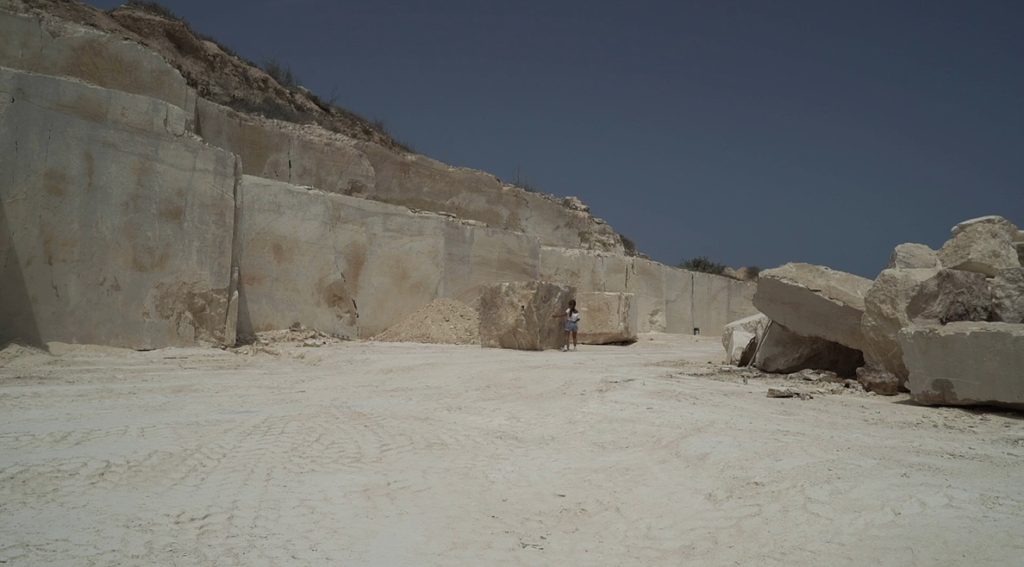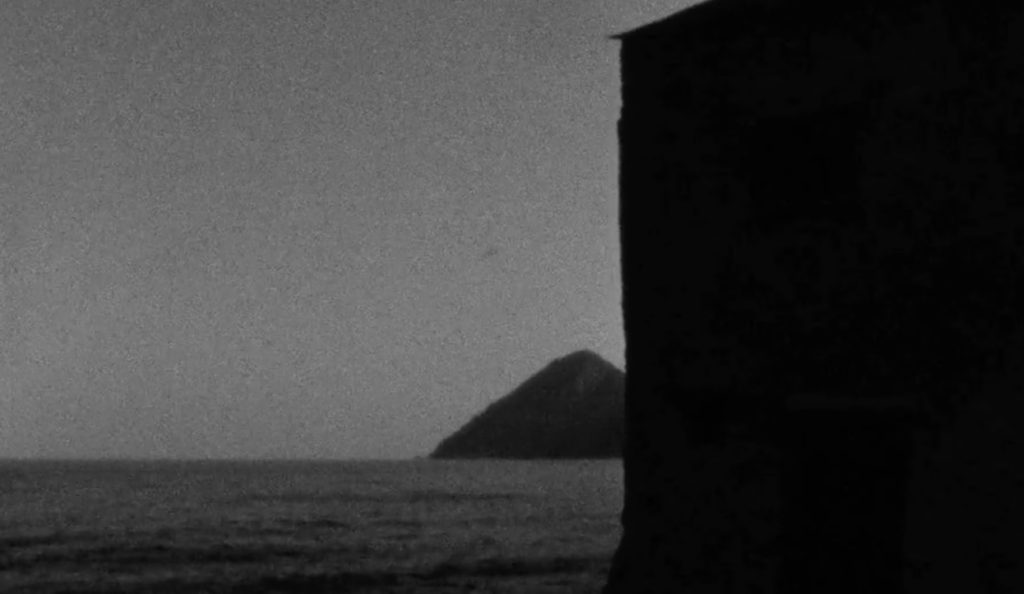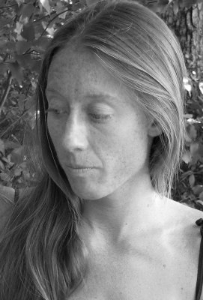by Megan Grumbling
The geological forms on which we live, build, and draw our borders sometimes seem so solid, so unchanging, that we forget their own long and ongoing lives of flux. And yet the material of the places we call home has a long history of being dug up or sloughed off, stacked high or submerged, compressed or spit out or sunk. In the two short films Lampedusa and Sublunary, by Mariangela Ciccarello and Philip Cartelli (2015 and 2019, Nusquam Productions), two Mediterranean islands become object lessons in such flux: one island is formed suddenly by volcano; another is a mass of pale gold stone that was once tiny, living crustaceans in the sea.
As Lampedusa and Sublunary explore the physical histories and shifts of these islands, they also offer subtle, lyrical meditations on the people who, for various reasons and lengths of time, inhabit them, as well as on such seemingly solid human institutions as the nation-state, geopolitical borders and identity, and even the idea of home itself.
The literal title island of Lampedusa is an island south of Italy; in the early 2000s, it became a destination for thousands of Libyans attempting dangerous emigration to Italy. But another island altogether (called Ferdinandea, among other names) is the subject of film’s story: this volcanic island briefly appeared off the coast of Sicily in 1831, setting off a four-nation land-grab race that proved moot when the island just as quickly disappeared into the sea. Ciccarello first wrote and published a story inspired by this island, using invented documents and narratives. Her and Cartelli’s film rendering, lent fraught modern allusion by its title, builds its narrative through images of rock, water, and endeavor, while its human words, spoken in multiple languages, punctuate rather than drive the island’s story.
Lampedusa opens with livid red rocks tumbling down the dark until a voice exclaims, “Land ho!” The film proceeds with slow images of smoke, water, and stone, and, gradually emerging amidst them, the narratives of several people who seek the island — all represented by one naked, wet man, a kind of Jungian Every-explorer. Sometimes we see the island as shot in grainy, grayscale, gorgeously textural Super 8 — gray smoke riffling down a dark slope, tiny silver dead fish on black rock, the over-exposed scintillation of sun on quivering water. Other times comes the contrast of vast, almost surreally serene HD long shots of blue seas and hazy skies, in which the rise of a distant island, is sometimes barely discernable as a slightly deeper shade of pale. The contrast between these aesthetics might be one of time and ways of knowing, between immediate, tactile immersion and a safer, easily glossed distance.
Over the course of the film, we hear different voices in different languages speak of landing on, naming, climbing, and planting a flag on the island, their words ranging from the jingoistic to the musically mythic: “It was strangely clear. The sirocco wind and ash rain of the last few days had disappeared.” And finally, late in the film, we hear a direct reference to the island of the title, and to a horror that occurred as recently as 2013: “A boat full of migrants has sunk at Lampedusa.” But the film’s sound design makes even more visceral the sounds of nonverbal urge and flux: So intimately, so internally do we hear human breathing, rocks jostled underfoot, the constant motion of water, that all of these movements — those of humans, water, and stone alike — at times seem to be forces equally of physics and of desire.
The charged modern conflicts of human passage over land and sea are made more explicit in Sublunary. The film opens with shots of striking cliffs and arches of gold rock: This is Globigerina limestone, for thousands of years the chief natural resource and building material of Malta, the EU island republic that has also seen a politically contentious influx of African migrants. After these dramatic shots of limestone formations, we cut to a young woman’s hands at a table and laptop as she pulls a stone out of bubble wrap. She then turns to the laptop, closes an Italian newsfeed about Italy and Malta’s recent static over “immigranti,” and finds her way to a micro-photograph of Maltese limestone. She is trying, we understand, to identify the stone in her hand. Does it, despite having been presumably been found beyond Malta’s borders, belong to its unique family of stone? Could it be called “Maltese”?

Her journey leads her down Valetta’s streets of luminous limestone buildings, into a limestone quarry, through a museum of ancient limestone figures, their features long weathered away. She runs fingers over the rutted surfaces of limestone walls, crawls on hands and knees over limestone floors, scratches limestone dust off of a stone with a finger. And her investigation of the island’s stone also includes the new arrivals moving on and over it. She reads about Maltese detention centers, sees a migrant rescue ship (seized by the Maltese government) docked in the harbor, and hears the voice of a migrant child saying that the stone looks like gold. Myriad voices form a fragmented montage of her experience on Malta: a migrant woman tells of being told to go back home; international newscasters talk migration statistics. And as in Lampedusa, the voices of the elements are our touchstone, as we return again and again to the rushing sounds of the sea, where this uniquely Maltese rock was once alive and where it continues to be shaped, worn, and washed away.
To put geological history in conversation with human migration as lyrically as Ciccarello and Cartelli do in these films recalls two novels that do something similar: Jenny Erpenbeck’s Visitation, in which the millennia-long lifespan of a glacial lake in Germany is juxtaposed against the changing owners of a house on its shore through the seizures, disappearances, and reclamations before, during, and after World War II; and Jose Saramago’s novel The Stone Raft, wherein both a bureaucratic crisis and some transnational communion ensue when the tip of the Iberian peninsula floats away. The medium of film, and Ciccarello and Cartelli’s particular subtlety and vision with it, allows us to consider similar questions in a different state, one in which words — and thus a particular kind of human reasoning — are adjunct to image and sound.
Finding ways to find new fluency in flux becomes ever more crucial for us all, of course, as we become ever more aware of our own impact on land and sea, and so on the movements of ourselves and of our neighbors. More and more, we see the dangers of cleaving too tightly to any too-static sense of place, belonging, or identity; more and more, we realize the fluidity and mutability of the materials even of narrative.
Indeed, to watch Lampedusa and Sublunary is to experience both the terror and the relief — even the euphoria — of realizing that nothing of stone, flesh, or story is static, that all continues to be reshaped, reformed, retold. “I saw no sign of solid rock,” a voice intones in Lampedusa as he beholds the sudden new island, and his words feel like a pronouncement on the world itself.
Lampedusa and Sublunary will screen Saturday, September 21, 2019 in Freeport, Maine, from 7pm to 8pm. The filmmakers will be in attendance for a Q+A following the films. If you would like to attend, please register to receive directions by emailing your name to info@thechart.me.
Megan Grumbling is a poet, editor, and teacher in Portland. Her new poetry collection, Persephone in the Late Anthropocene, is forthcoming in 2020.


